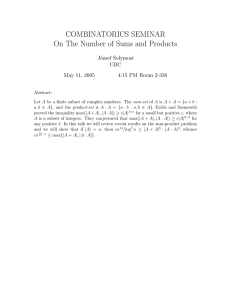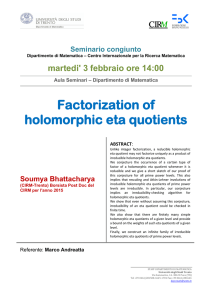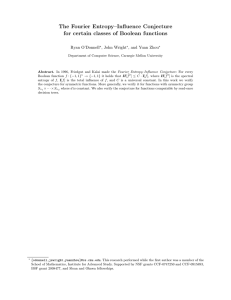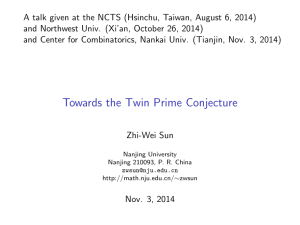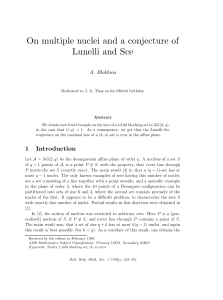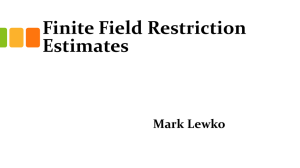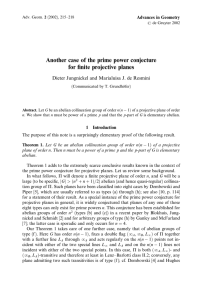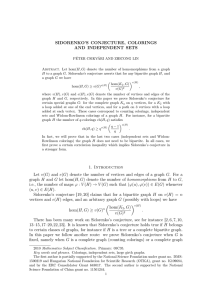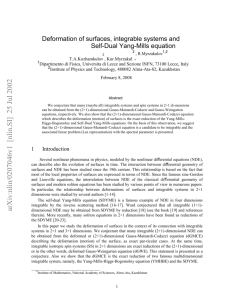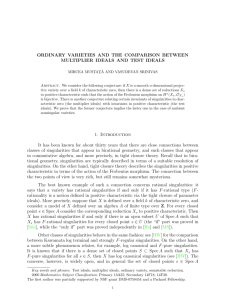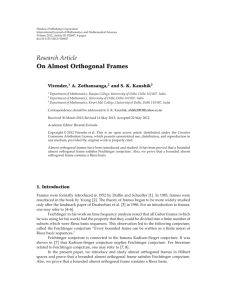The Erd˝os-Moser Conjecture An Application of Linear Algebra to Combinatorics M.I.T.
advertisement
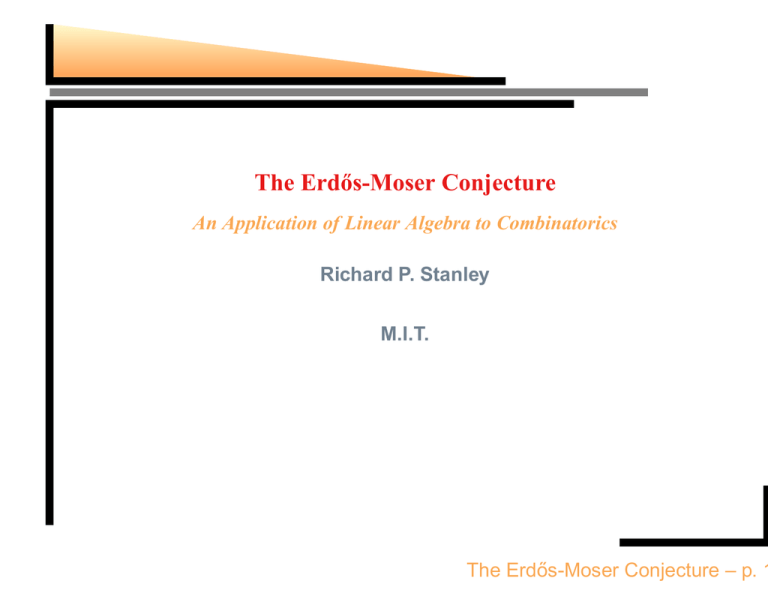
The Erdős-Moser Conjecture
An Application of Linear Algebra to Combinatorics
Richard P. Stanley
M.I.T.
The Erdős-Moser Conjecture – p. 1
The function f (S, α)
Let S ⊂ R, #S < ∞, α ∈ R.
f (S, α) = #{T ⊆ S :
N OTE .
P
i∈∅ i
X
i = α}
i∈T
=0
The Erdős-Moser Conjecture – p. 2
The function f (S, α)
Let S ⊂ R, #S < ∞, α ∈ R.
f (S, α) = #{T ⊆ S :
N OTE .
P
i∈∅ i
X
i = α}
i∈T
=0
Example. f ({1, 2, 4, 5, 7, 10}, 7) = 3:
7=2+5=1+2+4
The Erdős-Moser Conjecture – p. 2
The conjecture for S ⊂ R
Example. ∀α f ({1,
√
2, π, 10, 100}, α) = 0, 1
The Erdős-Moser Conjecture – p. 3
The conjecture for S ⊂ R
Example. ∀α f ({1,
√
2, π, 10, 100}, α) = 0, 1
Erdős-Moser Conjecture.
#S = 2n + 1
⇒ f (S, α) ≤ f ({−n, −n + 1, . . . , n}, 0)
#S = 2n
⇒ f (S, α) ≤ f ({−n + 1, −n + 2, . . . , n}, 0)
The Erdős-Moser Conjecture – p. 3
The conjecture for S ⊂ R+
Let R+ = {i ∈ R : i > 0}.
The Erdős-Moser Conjecture – p. 4
The conjecture for S ⊂ R+
Let R+ = {i ∈ R : i > 0}.
Weak Erdős-Moser Conjecture.
S ⊂ R+ , #S = n
1 n+1
⇒ f (S, α) ≤ f {1, 2, . . . , n},
2
2
The Erdős-Moser Conjecture – p. 4
The conjecture for S ⊂ R+
Let R+ = {i ∈ R : i > 0}.
Weak Erdős-Moser Conjecture.
S ⊂ R+ , #S = n
1 n+1
⇒ f (S, α) ≤ f {1, 2, . . . , n},
2
2
1
1 n+1
N OTE . 2 2 = 2 (1 + 2 + · · · + n)
The Erdős-Moser Conjecture – p. 4
Posets
A poset (partially ordered set) is a set P with a
binary relation ≤ satisfying:
Reflexivity: t ≤ t
Antisymmetry: s ≤ t, t ≤ s ⇒ s = t
Transitivity: s ≤ t, t ≤ u ⇒ s ≤ u
The Erdős-Moser Conjecture – p. 5
Graded posets
chain: u1 < u2 < · · · < uk
The Erdős-Moser Conjecture – p. 6
Graded posets
chain: u1 < u2 < · · · < uk
Assume P is finite. P is graded of rank n if
P = P0 ∪ P1 ∪ · · · ∪ Pn ,
such that every maximal chain has the form
t0 < t1 < · · · < tn , ti ∈ Pi .
The Erdős-Moser Conjecture – p. 6
Diagram of a graded poset
Pn
..
.
Pn −1
P2
P1
P0
The Erdős-Moser Conjecture – p. 7
Rank-symmetry and unimodality
Let pi = #Pi .
Rank-generating function: FP (q) =
n
X
pi q
i
i=0
The Erdős-Moser Conjecture – p. 8
Rank-symmetry and unimodality
Let pi = #Pi .
Rank-generating function: FP (q) =
n
X
pi q
i
i=0
Rank-symmetric: pi = pn−i ∀i
The Erdős-Moser Conjecture – p. 8
Rank-symmetry and unimodality
Let pi = #Pi .
Rank-generating function: FP (q) =
n
X
pi q
i
i=0
Rank-symmetric: pi = pn−i ∀i
Rank-unimodal:
p0 ≤ p1 ≤ · · · ≤ pj ≥ pj+1 ≥ · · · ≥ pn for some j
The Erdős-Moser Conjecture – p. 8
Rank-symmetry and unimodality
Let pi = #Pi .
Rank-generating function: FP (q) =
n
X
pi q
i
i=0
Rank-symmetric: pi = pn−i ∀i
Rank-unimodal:
p0 ≤ p1 ≤ · · · ≤ pj ≥ pj+1 ≥ · · · ≥ pn for some j
rank-unimodal and rank-symmetric ⇒ j = ⌊n/2⌋
The Erdős-Moser Conjecture – p. 8
The Sperner property
antichain A ⊆ P :
s, t ∈ A, s ≤ t ⇒ s = t
• • ••
The Erdős-Moser Conjecture – p. 9
The Sperner property
antichain A ⊆ P :
s, t ∈ A, s ≤ t ⇒ s = t
• • ••
N OTE . Pi is an antichain
The Erdős-Moser Conjecture – p. 9
The Sperner property
antichain A ⊆ P :
s, t ∈ A, s ≤ t ⇒ s = t
• • ••
N OTE . Pi is an antichain
P is Sperner (or has the Sperner property) if
max #A = max pi
A
i
The Erdős-Moser Conjecture – p. 9
An example
rank-symmetric, rank-unimodal, FP (q) = 3 + 3q
The Erdős-Moser Conjecture – p. 10
An example
rank-symmetric, rank-unimodal, FP (q) = 3 + 3q
not Sperner
The Erdős-Moser Conjecture – p. 10
The boolean algebra
Bn : subsets of {1, 2, . . . , n}, ordered by inclusion
The Erdős-Moser Conjecture – p. 11
The boolean algebra
Bn : subsets of {1, 2, . . . , n}, ordered by inclusion
n
pi = i , FBn (q) = (1 + q)n
rank-symmetric, rank-unimodal
The Erdős-Moser Conjecture – p. 11
Diagram of B3
123
12
13
1
2
23
3
φ
The Erdős-Moser Conjecture – p. 12
Sperner’s theorem, 1927
Theorem. Bn is Sperner.
The Erdős-Moser Conjecture – p. 13
Sperner’s theorem, 1927
Theorem. Bn is Sperner.
Emanuel Sperner
9 December 1905 – 31 January 1980
The Erdős-Moser Conjecture – p. 13
The poset M (n)
M (n): subsets of {1, 2, . . . , n}, ordered as
follows:
The Erdős-Moser Conjecture – p. 14
The poset M (n)
M (n): subsets of {1, 2, . . . , n}, ordered as
follows:
Let
n ≥ a1 > a2 > · · · > ak ≥ 1
n ≥ b1 > b2 > · · · > bj ≥ 1
S = {a1 , . . . , ak }, T = {b1 , . . . , bj }
The Erdős-Moser Conjecture – p. 14
The poset M (n)
M (n): subsets of {1, 2, . . . , n}, ordered as
follows:
Let
n ≥ a1 > a2 > · · · > ak ≥ 1
n ≥ b1 > b2 > · · · > bj ≥ 1
S = {a1 , . . . , ak }, T = {b1 , . . . , bj }
Define S ≥ T if k ≥ j and
a1 ≥ b1 , a2 ≥ b2 , . . . , aj ≥ bj .
The Erdős-Moser Conjecture – p. 14
M (1), M (2), M (3)
321
32
21
31
1
2
3
φ
21
1
2
φ
1
φ
The Erdős-Moser Conjecture – p. 15
M (4)
4321
432
431
421
43
42
321
41
4
32
31
21
3
2
1
φ
The Erdős-Moser Conjecture – p. 16
Rank function of M (n)
Easy:
M (n)k = {S ⊆ {1, . . . , n} :
#M (n)k = f ({1, . . . , n}, k)
X
i = k}
i∈S
⇒ FP (q) = (1 + q)(1 + q 2 ) · · · (1 + q n )
The Erdős-Moser Conjecture – p. 17
Rank function of M (n)
Easy:
M (n)k = {S ⊆ {1, . . . , n} :
#M (n)k = f ({1, . . . , n}, k)
X
i = k}
i∈S
⇒ FP (q) = (1 + q)(1 + q 2 ) · · · (1 + q n )
Rank-symmetry clear: pi = #M (n)i = p(n+1) − i
2
The Erdős-Moser Conjecture – p. 17
Rank function of M (n)
Easy:
M (n)k = {S ⊆ {1, . . . , n} :
#M (n)k = f ({1, . . . , n}, k)
X
i = k}
i∈S
⇒ FP (q) = (1 + q)(1 + q 2 ) · · · (1 + q n )
Rank-symmetry clear: pi = #M (n)i = p(n+1) − i
2
Rank-unimodality is unclear (no combinatorial
proof known).
The Erdős-Moser Conjecture – p. 17
Lindström’s observation
Theorem. If M (n) is Sperner, then the weak
Erdős-Moser conjecture holds for #S = n.
The Erdős-Moser Conjecture – p. 18
Lindström’s observation
Theorem. If M (n) is Sperner, then the weak
Erdős-Moser conjecture holds for #S = n.
Weak Erdős-Moser Conjecture.
S ⊂ R+ , #S = n
1 n+1
⇒ f (S, α) ≤ f ({1, 2, . . . , n},
2
2
The Erdős-Moser Conjecture – p. 18
Lindström’s observation
Theorem. If M (n) is Sperner, then the weak
Erdős-Moser conjecture holds for #S = n.
Proof. Suppose S = {a1 , . . . , ak }, a1 > · · · > ak .
Let
ai1 + · · · + air = aj1 + · · · + ajs ,
where i1 > · · · > ir , j1 > · · · > js .
The Erdős-Moser Conjecture – p. 18
Conclusion of proof
Now {i1 , . . . , ir } ≥ {j1 , . . . , js } in M (n)
⇒ r ≥ s, i1 ≥ j1 , . . . , is ≥ js
⇒ ai1 ≥ bj1 , . . . , ais ≥ bjs
⇒ r = s, aik = bik ∀k.
The Erdős-Moser Conjecture – p. 19
Conclusion of proof
Now {i1 , . . . , ir } ≥ {j1 , . . . , js } in M (n)
⇒ r ≥ s, i1 ≥ j1 , . . . , is ≥ js
⇒ ai1 ≥ bj1 , . . . , ais ≥ bjs
⇒ r = s, aik = bik ∀k.
Thus ai1 + · · · + air = bj1 + · · · + bjs
⇒ {i1 , . . . , ir } and {j1 , . . . , js } are incomparable
or equal in M (n)
1 n+1
⇒ #S ≤ max #A = f {1, . . . , n},
A
2
2
The Erdős-Moser Conjecture – p. 19
Linear algebra to the rescue!
To prove: M (n) is Sperner.
The Erdős-Moser Conjecture – p. 20
Linear algebra to the rescue!
To prove: M (n) is Sperner.
P = P0 ∪ · · · ∪ Pm : graded poset
QPi : vector space with basis Q
U : QPi → QPi+1 is order-raising if
U (s) ∈ spanQ {t ∈ Pi+1 : s < t}
The Erdős-Moser Conjecture – p. 20
Order-matchings
Order matching: µ : Pi → Pi+1 : injective and
µ(t) < t
The Erdős-Moser Conjecture – p. 21
Order-matchings
Order matching: µ : Pi → Pi+1 : injective and
µ(t) < t
Pi +1
µ
Pi
The Erdős-Moser Conjecture – p. 21
Order-raising and order-matchings
Key Lemma. If U : QPi → QPi+1 is injective and
order-raising, then there exists an
order-matching µ : Pi → Pi+1 .
The Erdős-Moser Conjecture – p. 22
Order-raising and order-matchings
Key Lemma. If U : QPi → QPi+1 is injective and
order-raising, then there exists an
order-matching µ : Pi → Pi+1 .
Proof. Consider the matrix of U with respect to
the bases Pi and Pi+1 .
The Erdős-Moser Conjecture – p. 22
Key lemma proof
z
t1
Pi+1
}|
{
· · · tm · · · tn
6= 0
|
s1
.
.
..
.
Pi
|
.
6= 0|
sm
det 6= 0
∗
∗
∗
The Erdős-Moser Conjecture – p. 23
Key lemma proof
z
t1
Pi+1
}|
{
· · · tm · · · tn
6= 0
|
s1
.
.
..
.
Pi
|
.
6= 0|
sm
det 6= 0
⇒ s1 < t1 , . . . , sm < tm
∗
∗
∗
The Erdős-Moser Conjecture – p. 23
Minor variant
Similarly if there exists surjective order-raising
U : QPi → QPi+1 , then there exists an
order-matching µ : Pi+1 → Pi .
The Erdős-Moser Conjecture – p. 24
A criterion for Spernicity
P = P0 ∪ · · · ∪ Pn : finite graded poset
Proposition. If for some j there exist
order-raising operators
inj.
inj.
inj.
surj.
surj.
surj.
QP0 → QP1 → · · · → QPj → QPj+1 → · · · → QPn ,
then P is rank-unimodal and Sperner.
The Erdős-Moser Conjecture – p. 25
A criterion for Spernicity
P = P0 ∪ · · · ∪ Pn : finite graded poset
Proposition. If for some j there exist
order-raising operators
inj.
inj.
inj.
surj.
surj.
surj.
QP0 → QP1 → · · · → QPj → QPj+1 → · · · → QPn ,
then P is rank-unimodal and Sperner.
Proof. “Glue together” the order-matchings.
The Erdős-Moser Conjecture – p. 25
Gluing example
j
The Erdős-Moser Conjecture – p. 26
Gluing example
j
The Erdős-Moser Conjecture – p. 26
Gluing example
j
The Erdős-Moser Conjecture – p. 26
Gluing example
j
The Erdős-Moser Conjecture – p. 26
Gluing example
j
The Erdős-Moser Conjecture – p. 26
Gluing example
j
The Erdős-Moser Conjecture – p. 26
A chain decomposition
P = C1 ∪ · · · ∪ Cpj (chains)
A = antichain, C = chain ⇒ #(A ∩ C) ≤ 1
⇒ #A ≤ pj .
The Erdős-Moser Conjecture – p. 27
Back to M (n)
n+1
2
Since M (n) has rank
and is self-dual,
suffices to find injective order-raising operators
n+1
U : QM (n)i → QM (n)i+1 , i <
2
The Erdős-Moser Conjecture – p. 28
How to find U ?
The Erdős-Moser Conjecture – p. 29
How to find U ?
The Erdős-Moser Conjecture – p. 29
Definition of U
For s ∈ M (n)i define
U (s) =
X
t
t∈M (n)i+1
s<t
The Erdős-Moser Conjecture – p. 30
Definition of U
For s ∈ M (n)i define
U (s) =
X
t
t∈M (n)i+1
s<t
We don’t know how to choose µ(s), so we make
all possible choices at once (a “quantum”
matching).
The Erdős-Moser Conjecture – p. 30
How to prove injectivity?
The Erdős-Moser Conjecture – p. 31
How to prove injectivity?
The Erdős-Moser Conjecture – p. 31
A lowering operator
Define D : QPi → QPi−1 by
X
D(t) =
c(s, t)s,
s∈M (n)i−1
s<t
where c(s, t) is given as follows.
s = {a1 > · · · > aj } ⊆ {1, . . . , n}
t = {b1 > · · · > bk } ⊆ {1, . . . , n}
There is a unique r for which ar = br − 1 (and
am = bm for all other m). In the case br = 1 we set
ar = 0.
The Erdős-Moser Conjecture – p. 32
Two examples
Example. s = {8, 7, 4, 2}, t = {8, 7, 5, 2} ⇒ r = 3
The Erdős-Moser Conjecture – p. 33
Two examples
Example. s = {8, 7, 4, 2}, t = {8, 7, 5, 2} ⇒ r = 3
Example. s = {5, 4}, t = {5, 4, 1} ⇒ r = 3
The Erdős-Moser Conjecture – p. 33
Definition of c(s, t)
c(s, t) =
(
n+1
2
, if ar = 0
(n − ar )(n + ar + 1), if ar > 0.
D(t) =
X
s∈M (n)i−1
s<t
c(s, t)s, t ∈ M (n)i
The Erdős-Moser Conjecture – p. 34
Why this choice of U and D ?
Lemma.
n+1
Di+1 Ui − Ui−1 Di =
− 2i Ii .
2
(Subscripts denote level at which operator acts.)
The Erdős-Moser Conjecture – p. 35
Why this choice of U and D ?
Lemma.
n+1
Di+1 Ui − Ui−1 Di =
− 2i Ii .
2
(Subscripts denote level at which operator acts.)
Proof. Straightforward computation.
The Erdős-Moser Conjecture – p. 35
Injectivity
Claim: Di+1 Ui : QM (n)i → QM (n)i has positive
1 n+1
eigenvalues for i < 2 2 .
The Erdős-Moser Conjecture – p. 36
Injectivity
Claim: Di+1 Ui : QM (n)i → QM (n)i has positive
1 n+1
eigenvalues for i < 2 2 .
Proof: Induction on i. Trivial to check i = 0: the
matrix is [1].
The Erdős-Moser Conjecture – p. 36
Injectivity
Claim: Di+1 Ui : QM (n)i → QM (n)i has positive
1 n+1
eigenvalues for i < 2 2 .
Proof: Induction on i. Trivial to check i = 0: the
matrix is [1].
Recall from linear algebra:
V, W : finite-dimensional vector spaces
A : V → W, B : W → V : linear transformations
⇒ xdim W det(I − xBA) = xdim V det(I − xAB)
The Erdős-Moser Conjecture – p. 36
Eigenvalues of Di+1Ii
Thus AB and BA have same nonzero
eigenvalues.
n+1
Recall: Di+1 Ui − Ui−1 Di =
− 2i Ii .
2
The Erdős-Moser Conjecture – p. 37
Eigenvalues of Di+1Ii
Thus AB and BA have same nonzero
eigenvalues.
n+1
Recall: Di+1 Ui − Ui−1 Di =
− 2i Ii .
2
Assume induction hypothesis for i − 1, i.e.,
Di Ui−1 has positive eigenvalues.
The Erdős-Moser Conjecture – p. 37
Eigenvalues of Di+1Ii
Thus AB and BA have same nonzero
eigenvalues.
n+1
Recall: Di+1 Ui − Ui−1 Di =
− 2i Ii .
2
Assume induction hypothesis for i − 1, i.e.,
Di Ui−1 has positive eigenvalues.
Thus Ui−1 Di has nonnegative eigenvalues.
The Erdős-Moser Conjecture – p. 37
Eigenvalues of Di+1Ii
Thus AB and BA have same nonzero
eigenvalues.
n+1
Recall: Di+1 Ui − Ui−1 Di =
− 2i Ii .
2
Assume induction hypothesis for i − 1, i.e.,
Di Ui−1 has positive eigenvalues.
Thus Ui−1 Di has nonnegative eigenvalues.
Eigenvalues
of Di+1 Ui exceed those of Ui−1 Di
by n+1
− 2i > 0. 2
The Erdős-Moser Conjecture – p. 37
Completion of proof
We showed:
Di+1 Ui has positive eigenvalues,
i < 21 n+1
.
2
Thus: Di+1 Ui is invertible.
If v ∈ ker(Ui ) then v ∈ ker(Di+1 Ui ), so Ui is
injective.
The Erdős-Moser Conjecture – p. 38
Completion of proof
We showed:
Di+1 Ui has positive eigenvalues,
i < 21 n+1
.
2
Thus: Di+1 Ui is invertible.
If v ∈ ker(Ui ) then v ∈ ker(Di+1 Ui ), so Ui is
injective.
⇒ weak Erdős-Moser conjecture is true!
The Erdős-Moser Conjecture – p. 38
Completion of proof
We showed:
Di+1 Ui has positive eigenvalues,
i < 21 n+1
.
2
Thus: Di+1 Ui is invertible.
If v ∈ ker(Ui ) then v ∈ ker(Di+1 Ui ), so Ui is
injective.
⇒ weak Erdős-Moser conjecture is true!
The Erdős-Moser Conjecture – p. 38
The original conjecture
Recall weak conjecture was for S ⊂ R+ , original
conjecture for S ⊂ R.
Original conjecture can be proved in several
ways:
The Erdős-Moser Conjecture – p. 39
The original conjecture
Recall weak conjecture was for S ⊂ R+ , original
conjecture for S ⊂ R.
Original conjecture can be proved in several
ways:
Combinatorial argument using the weak
conjecture (Kleitman)
Spernicity of M (n) × M (n)∗ using same
methods, where M (n)∗ is the dual of M (n).
Note: M (n) ∼
= M (n)∗
Use results on preservation of Spernicity
under product.
The Erdős-Moser Conjecture – p. 39
How were U and D found?
∗
QM (n) ∼
H
(SO(2n + 1, C)/P ; Q)
=
The Erdős-Moser Conjecture – p. 40
How were U and D found?
∗
QM (n) ∼
H
(SO(2n + 1, C)/P ; Q)
=
∼
= Vspin,
the weight space of the spin representation of
SO(2n + 1, C).
The Erdős-Moser Conjecture – p. 40
How were U and D found?
∗
QM (n) ∼
H
(SO(2n + 1, C)/P ; Q)
=
∼
= Vspin,
the weight space of the spin representation of
SO(2n + 1, C).
Reduced to linear algebra by Proctor.
The Erdős-Moser Conjecture – p. 40
What next?
The Erdős-Moser Conjecture – p. 41
What next?
The Erdős-Moser Conjecture – p. 41
